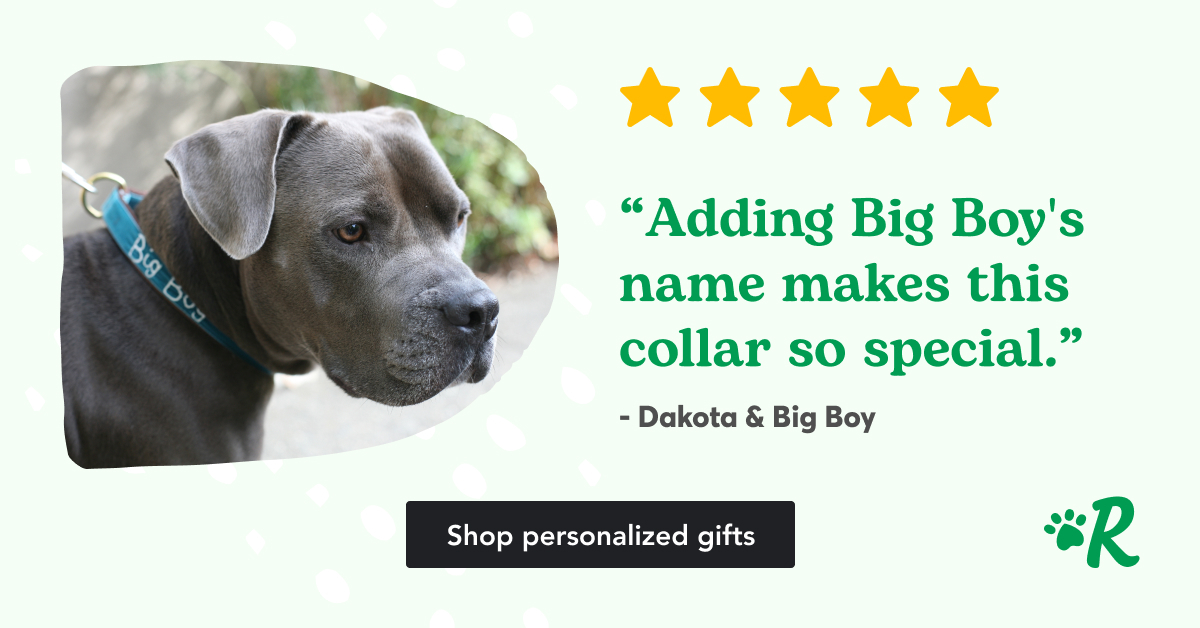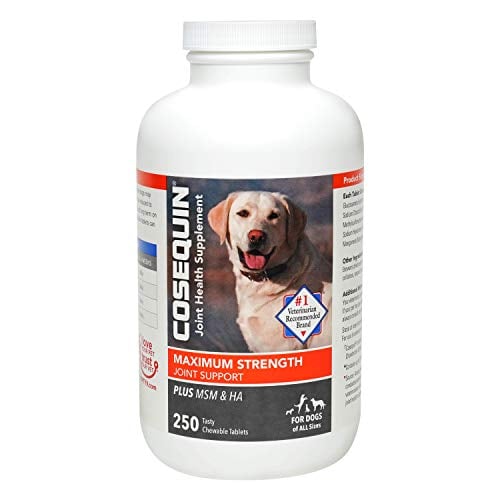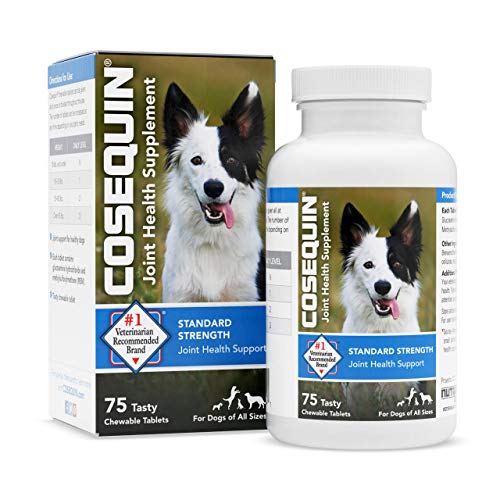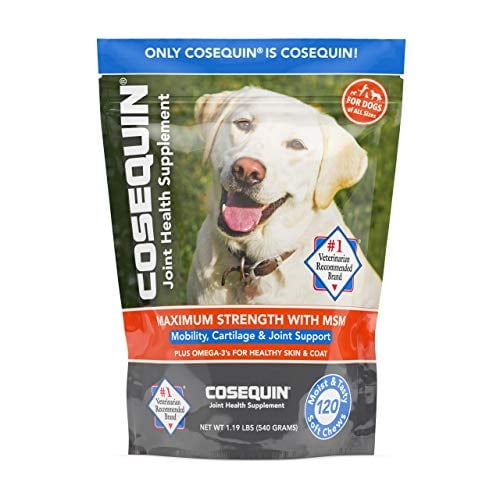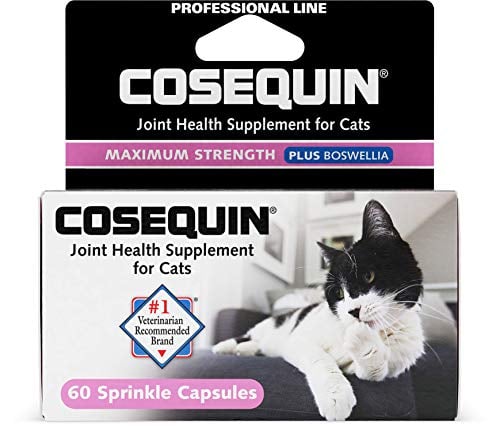- This post contains affiliate links. Read more here.
- Not a substitute for professional veterinary help.
Cosequin is everywhere these days. It’s the supplement of choice for dogs and cats with joint problems, and it feels like every mature pup and kitty you run into is taking it. But what is it? How does it work? And does it really get results? Here’s what’s known—and unknown—about the supplement, plus our own pets’ take on the famous pill.
What Is Cosequin?
No pet parent likes to admit that their dogs are getting older, and I’m no exception. Unfortunately, that fact is getting harder for me to deny. My dogs Miss Bennet and Logan are 12 and 10 years old now, respectively.
As seniors, my dogs are as loud and goofy and sassy as they ever were—age has brought no wisdom and little calm to our home—and yet they’re increasingly finding themselves at the mercy of their aging bodies. Some days, the discomfort of osteoarthritis and other age-related issues visibly dampens that spunk.
Early last year, my local veterinarian recommended that we try Cosequin, a joint supplement that aims to keep pets like mine moving, restoring the quality of life that fades when mobility is limited.
So I did some digging into the product and spoke with Dr. Rebecca Greenstein, a Veterinary Medical Advisor for Rover, to learn more.
Cosequin is a branded suite of nutritional supplements—also called “nutraceuticals”—produced by Nutramax Laboratories, a manufacturer of supplemental health products for both humans and pets. Cosequin is intended to address arthritis and stiffness of the joints and ligaments in dogs and cats.
As with humans, a dog’s or cat’s musculoskeletal system gives their body structure and movement. In this system, bones and muscles are tied together with tendons and ligaments.
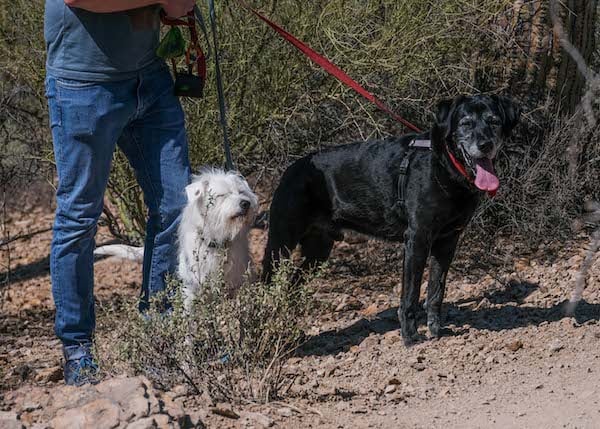
Miss Bennet and Logan model musculoskeletal systems.
Joints are the points in the body where two bones meet. Cartilage covers the ends of the bones at these junctures to cushion and protect them as they move against each other.
But as our dogs and cats age, this cartilage often breaks down, making it more difficult to move and causing painful friction between the bones at the joints. This degradation, which is called osteoarthritis, can develop due to injury, infection, and autoimmune disorders as well as age.
But arthritis isn’t just an “old dog disease,” according to Dr. Greenstein. She told me that as many as 20% of dogs one year or older have osteoarthritis, and young cats aren’t immune either.
The primary ingredients in Cosequin are Glucosamine Hydrochloride and Sodium Chondroitin Sulfate. Some products sold within the Cosequin brand also contain MSM (Methylsulfonylmethane) or other additions like Omega-3s.
Dr. Greenstein explained that, in a simplified sense, glucosamine helps build healthy cartilage in the joints, while chondroitin protects against inflammation and damage. MSM, she said, does a little bit of both.
Is Cosequin Safe?
Cosequin claims to be the number-one joint-health supplement brand recommended by veterinarians and used by pet parents. According to Dr. Greenstein, Cosequin’s popularity is largely due to Nutramax Laboratories’ good reputation for quality and research.
The question of safety around supplements—including Cosequin for dogs and cats—is a complicated one. There’s medical safety and anecdotal safety, and they’re not necessarily the same.
Because supplements and nutraceuticals are not regulated in the same ways as pharmaceuticals, the quality and effectiveness of these products can vary widely. For veterinarians, peer reviews are what Dr. Greenstein called the gold standard for understanding a nutraceutical’s safety and efficacy. Practical, widespread experience can also play a tentative role, and Cosequin has benefitted from both.

Oscar takes Cosequin so he can go on more hikes.
“Based on our collective veterinary experience with Cosequin, it seems to be very well-tolerated,” she said. “The rate of serious adverse reactions seems to be pretty low based on what we know about it.”
Alternatives to Cosequin for Dogs and Cats: Are All Joint Supplements Created Equal?
When it comes to joint supplements in general, Dr. Greenstein’s warning was clear: not all supplements are the same. Though Cosequin has earned a solid reputation, not all supplements have been so widely tested. This warning doesn’t come from loyalty to Cosequin or any other particular product, she clarifies, but from the general lack of research and regulation related to pet supplements.
“It’s not just a question of glucosamine supplements in general,” she said. “It’s a larger question of quality control, and is what’s in the bottle accurate? And if it is, are all products created equal? And it turns out they’re not.”
Because of this, she says that the specific products you choose for your pets do matter. Pet parents shouldn’t grab the first joint supplement they see, even if the manufacturer markets it for pets. While those products might be safe and effective, there’s no way to be sure.
Just as important, you don’t want to give your pets joint supplements made for humans.
“Not all glucosamine supplements are appropriate. They don’t all work the same,” Dr. Greenstein told me. “Human products don’t necessarily translate to dogs and cats.”
Who Benefits From Cosequin?
Mature dogs and cats experiencing joint stiffness are both likely to benefit from Cosequin—though it’s important to check with your vet first.
The news might surprise many cat parents, since dogs are more often known to suffer from joint issues. Dr. Greenstein, however, suspects that osteoarthritis affects more cats than we know.
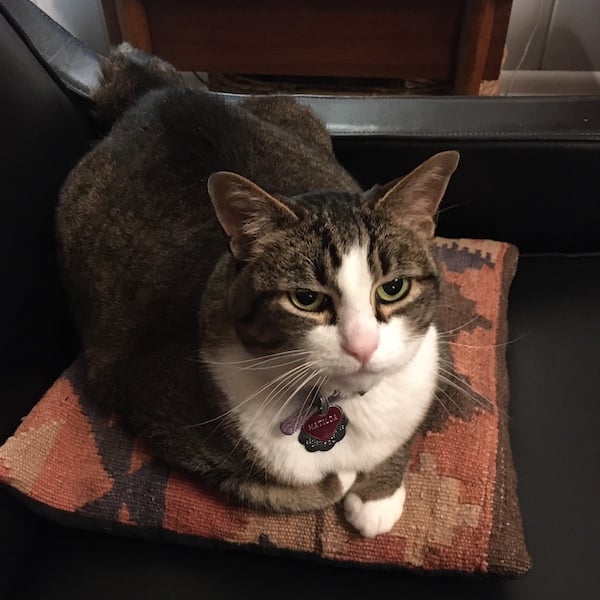
Matilda, being affected by osteoarthritic issues.
“We’re not as good at picking out the signs because cats are more stoic,” she told me. She pointed to stiffness when getting up or difficulty jumping up as signals that cats may be experiencing some joint discomfort.
I asked Dr. Greenstein if younger pets would benefit from starting Cosequin early, particularly given the high prevalence of osteoarthritis. She told me that it’s possible; preventative dosing might help younger dogs in preserving their joint health over time, but the research isn’t definitive enough to know for sure.
“We are still in an early stage of understanding who would benefit and why and which products are the ones that would work,” she told me.
Most of the existing research, she said, was conducted on dogs with diagnosed joint issues like osteoarthritis. For now, recommendations of Cosequin for dogs and cats are mostly made when there’s a known issue.
How Cosequin for Dogs Has Helped My Senior Pups
Miss Bennet, a scruffy mix of Terrier and Schnauzer and who-knows-what-else, is twelve. Most days she barely seems to be slowing down, but she woke me up one morning last year in obvious distress. A trip to the emergency vet and a set of x-rays revealed arthritis in her back leg.
Logan is a black Labrador Retriever. At ten, his aging is far more obvious. Over the last several years, white hairs have grown in around his eyes and snout, a feature that might suggest a certain amount of wisdom if you didn’t know him. In reality, he’s a goofball, but he has arthritis and back issues to boot.
At 60 pounds, Logan gets a whole tablet of Cosequin every day, while Miss Bennet gets half. We put the pills in their bowls with their breakfast, and it’s usually the first thing they eat. (It’s a good idea to have your pet take Cosequin with food, since some say it can be a little rough on an empty stomach.)

Miss Bennet and Logan, looking dapper and mobile, if we do say so ourselves.
Within weeks, we saw a difference; both dogs were moving more freely and more often—in fact, we found ourselves having to watch Logan, as his improvement showed most in his reckless enthusiasm for life.
My dogs aren’t the only ones who seem to have benefited from the product either; several weeks after my husband recommended Cosequin to a colleague, his coworker reported that his dog had greeted him at the door after work for the first time in a long time.
Oscar the Rover test pup takes Cosequin at his vet’s direction and gets around remarkably speedily on his tiny old legs (and into all kinds of mischief).
So does Matilda, a mature kitty who continues to test Rover products with enthusiasm (or, well, what counts as enthusiasm for a cat). She was prescribed Cosequin by her vet to help with joint issues caused by arthritis.
Cosequin isn’t, however, a cure. While it seems to have made a big difference in Logan’s and Miss Bennet’s comfort and mobility, it hasn’t turned back the clock or made their joint problems vanish. In the last several months, we noticed that Logan’s activity and stability were beginning to regress again; now we’re continuing his daily regimen of supplements and working on other treatments as well, including regular trips to a specialized dog gym.
But for us, the difference has been remarkable, and we’ve recommended the product to family, friends, and colleagues alike.

Logan and Miss Bennet play on the beach.
How To Buy Cosequin
Cosequin comes in a variety of forms, including tablets and chews and unique formulas for dogs, cats, and even horses. We’ve included some of the most common options below, but pet parents may find other products better suited to their pet’s needs.
As a supplement, all Cosequin products are available without a prescription. However, pet parents should always discuss these options with their veterinarian before starting any supplemental treatments with their dog or cat. If you’re buying on a third-party site like Amazon, it’s also important to double-check that the product’s seller and manufacturer is Nutramax—that way you’ll avoid any counterfeit products.
